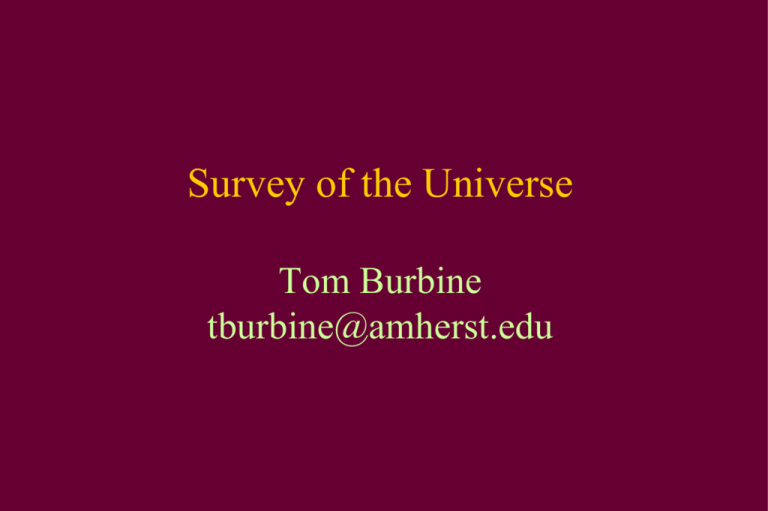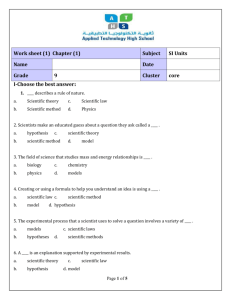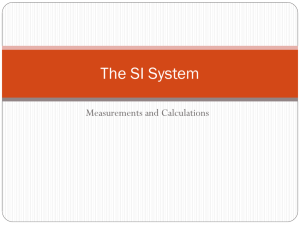January 28
advertisement

Survey of the Universe Tom Burbine tburbine@amherst.edu Readings • Should start reading Units 1-4 Stellarium • Everybody should download the program Stellarium • http://www.stellarium.org/ • Need to change your location Office Hours • M-W 10-11 am in Kendade 221 Help Sessions • 7-10 pm on Sundays and Tuesdays • First Help Session will be Feb. 3 in Kendade (email on room number later) HW #1 • HW #1 is due Feb. 6 Stars • Stars are composed primarily of Hydrogen and Helium • Generate energy through nuclear fusion Sun • Our star • Typical star since the msses of stars range from 0.1 to 100 solar masses • 1 solar mass is the mass of the Sun http://www.aerospaceguide.net/solar_system/sun.html Stellar evolution • Stars are born • Live • And then die Galaxies • Galaxies are massive gravitationally bound systems of stars and stellar remnants, gas, dust, planets, and dark matter • Dark matter is matter that you can’t see but whose gravity affects visible matter and background radiation Milky Way Galaxy • Our Galaxy • 100-400 billion stars http://www.astro.keele.ac.uk/workx/milkyway/page.html Galaxies • Taken over 11 days • Over 10,000 objects apparent (majority are galaxies) • There are estimated to be more than 176 billion galaxies in the observable universe Light-year • Distance that light travels in a year • Light travels at a speed of 300,000,000 m/s in a vacuum • 1 light year = 10,000,000,000,000,000 meters Local Group • Gravitationally bound group of galaxies that the Milky Way is a member of • Contains more than 30 galaxies http://hendrix2.uoregon.edu/~imamura/123/lecture-3/lecture-3.html Big Bang • Explosion that started the Universe Why do we use the metric system in science? • A system based on multiples of 10 is much more intuitive for humans • We are born with 10 fingers and toes • The math system that we use is based on 10 Metric System • Any system of measurement needs three fundamental units – Length - meter – Mass - kilogram – Time - second • • • • 1 kilometer = 1,000 meters 1 meter = 100 centimeters 1 centimeter = 10 millimeters 1 kilogram = 1,000 grams Things you need to know because we will use the metric system • • • • • • one kilometer is 5/8 of a mile one meter is 3.28 feet one centimeter is 0.39 inches 1 kg (mass) is equivalent to 2.2 pounds (force) on Earth We will use the metric system in this class Does anybody remember the Mars Climate Orbiter? Mars Climate Orbiter • Software calculated forces for the thrusters in English units (pounds). • People controlling the spacecraft thought the calculated forces were in Newtons (metric). (One English pound of force equals 4.45 Newtons.) • Changes made to the spacecraft's trajectory were actually 4.45 times greater than what the JPL navigation team believed. • The spacecraft missed its intended 140 150 km altitude above Mars during orbit insertion, instead entering the Martian atmosphere at about 57 km. http://en.wikipedia.org/wiki/Image:Mars_Climate_Orbiter_2.jpg • The spacecraft was destroyed • • • • • • • 1 kilometer = 1,000 meters 1 meter = 100 centimeters 1 centimeter = 10 millimeters 1 kilogram = 1,000 grams one kilometer is 5/8 of a mile one meter is 3.28 feet 1 kg (mass) is equivalent to 2.2 pounds (force) on Earth Meter • How is the meter defined? Meter • Originally intended to be one ten-millionth of the distance from the Earth's equator to the North Pole • International Prototype Meter was defined as the distance between two lines on a standard bar composed of an alloy of ninety percent platinum and ten percent iridium, measured at the melting point of ice. Meter • Now defined as equal to the distance travelled by light in vacuum during a time interval of 1⁄299,792,458 of a second. Gram and Kilogram • How are the gram and kilogram defined? Gram and Kilogram • How are the gram and kilogram defined? Gram and Kilogram • A gram was first decreed to be equal to “the absolute weight of a volume of water equal to the cube of the hundredth part of the meter, at the temperature of melting ice.” • Now, the International Prototype Kilogram is used as the standard. • It is made of a platinum alloy known as “Pt-10Ir”, which is 90% platinum and 10% iridium International Prototype Kilogram • Photo of Danish national kilogram prototype Other Units used in Astronomy • • • • Solar mass – Mass of Sun Jupiter mass – Mass of Jupiter Light year – Distance light travels in a year Astronomical Unit – Average distance between the Sun and the Earth • Speed of light (c) - 3 x 108 m/s Scientific Notation • • • • • • 10000 = 104 100000000 = 108 10000000000 = 1010 100000000000000000000 = 1020 0.001 = 10-3 0.0000001 = 10-7 How do you write numbers? • • • • 31,700,000 = 3.17 x 107 2,770,000 = 2.77 x 106 0.00056 = 5.6 x 10-4 0.0000078 = 7.8 x 10-6 How do you do multiply? • 106 x 108 = 10(6+8) = 1014 • 10-5 x 103 = 10(-5+3) = 10-2 • (3 x 104 ) x (4 x 105) = 12 x 10(4+5) = 12 x 109 = 1.2 x 1010 How do you divide? • 108/106 = 10(8-6) = 102 • 10-6/10-4 = 10(-6-(-4)) = 10-2 • (3 x 108)/(4 x 103) = ¾ x 10(8-3) = 0.75 x 105 = 7.5 x 104 Always use units for your answers Stars in the Universe • Say there are 100 billion galaxies • Each galaxy has 100 billion stars • So how many stars in the universe Answer • Number of stars in universe • = (100 x 109) x (100 x 109) = 10000 x 1018 = 1 x 1022 = 10,000,000,000,000,000,000,000 • This is about the same number of grains of sand in every beach in the world Questions: • How many of these 1022 stars have planets? • How many of these planets have life? Any Questions?








